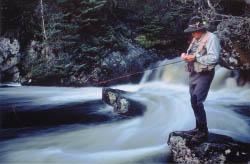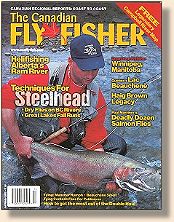The Absolute Beginner
Panfish: A fun way to practice Stillwater techniques

By Piscator
Panfish got their name because, traditionally, the main reason people
fished for them was to eat them. Unlike gamefish, rarely were they fished just
for the fun of it. But that doesn't mean that panfishing is dull. Far from it: panfish
can provideplenty of action for the fly fisher: Moreover; they also provide an
excellent opportunity for the novice to hone his skills.
The species included in this group varies throughout North America, but the
most generally targeted by fly fishers are bluegill, pumpkinseed, yellow perch,
crappie, and rock bass.
While all of these species can be quite common on moving water; they're even
more common in stillwater: In most places, one or more species are present in
large numbers. They're also usually easy to access, because they tend to locate
around structures close to shore - such as docks and rip-rap. While a boat
helps, it isn't necessary.
Most panfish take flies readily, but not so readily that they're too easy. Except,
perhaps, for rock bass, panfish tend to approach flies (especially on the surface)
cautiously and slowly. This provides just that right degree of difficulty and
challenge to make the novice stretch - a perfect learning situation.
Panfish will take both surface and sub-surface flies, but the latter are taken more
readily.
On the Surface
Medium-sized bushy dry flies seem to work better than poppers, as most
panfish have relatively small mouths and tend to just peck at the latter. The
exception is the rock bass, which has a bigger mouth and will often engulf a bug
intended for smallmouth or largemouth. Wulff's, Hair Wing Caddis, and similar
durable, high-floating trout patterns in sizes #8 - #14 are good choices.
Cast these close to the edges of submerged rock piles, logs, rip-rap, lily pads,
weed beds, and dock pillings. When the fly hits the water, let it sit. Bluegill and
pumpkinseed, especially approach a surface fly very cautiously. Watch for them
hanging just beneath it, scrutinising it. When the take comes, it's usually a gentle
sucking. Only rock bass will hit your offering aggressively. This can furnish an
excellent lesson in patience.
Be prepared to leave the fly there for at least three or four minutes. If nothing
grabs it, give it a couple of tiny twitches, then let it sit again. Repeat this a few
times, exploring along the edge of the structure until you stir up some action.
You'll find that you'll frequently take a number of fish from the same place.
The only popular panfish which does not take a surface fly readily is a yellow
perch, although I have a couple of ten inch specimens in my garden pond which
compete aggressively with fifteen inch koi for floating pellets.
Beneath the Surface
Like the surface patterns, sub-surface flies should be small (#10 - #16). Nymphs
are best, and almost any impressionistic pattern will do, as these fish are rarely
selective. If you're targeting rock bass, you can use somewhat biggers patterns, such
as Woolly Buggers up to #6.
Fly nymphs in the same place you'd fish dry flies. There are two basic techniques.
The first of these is where you can see the fly and watch the take. Depending upon
the clarity of the water, this can be at any depth from a couple of inches to a number
of feet. The technique is simple just watch the fly (you can use both weighted and
unweighted nymphs) sink and keep your eye open for panfish approaching it. They'll
move in slowly, fins bristling. Eventually, one will approach within inches, then dart
in and grab it. That's when you set the hook.
In some places, you can watch the fly sink all the way to the bottom. If nothing
has hit it on the way down, give it a couple twitches and let it sink again. If there's
still no action, move to another place. However, panfish are usually so prolific,
that you'll have little difficulty in spotting fish to cast to.
In situation where the water is too murky to see more than a couple inches below
the surface, you'll have to watch the leader for indications of a take. This is quite
a bit more difficult than sight fishing, as the subtle takes can be extremely hard
to detect. Sometimes, the movement of the leader will be minute. Sometimes
they will be imperceptible. This means you'll invariably miss a number of fish,
because you won't know they've grabbed the fly. A strike indicator can help
out here, but make sure you keep moving it up and down the leader in order to
vary the depth of which your nymph sinks. A weighted nymph is preferable to
an un-weighted one.
Equipment
 You can use your trout gear for panfish. A five weight or lighter outfit with
floating line is ideal. The leader need not be any longer than nine feet, with
a 4X tippet. When fishing dry make sure you grease both line and leader to
within a couple inches of the fly. When fishing beneath the surface, degrease the
leader to allow the fly to sink. However you can grease the upper half of the
leader to make it float and suspend the nymph between the surface and the
bottom when the fish are holding off the bottom. It will also act as a strike
indicator.
You can use your trout gear for panfish. A five weight or lighter outfit with
floating line is ideal. The leader need not be any longer than nine feet, with
a 4X tippet. When fishing dry make sure you grease both line and leader to
within a couple inches of the fly. When fishing beneath the surface, degrease the
leader to allow the fly to sink. However you can grease the upper half of the
leader to make it float and suspend the nymph between the surface and the
bottom when the fish are holding off the bottom. It will also act as a strike
indicator.
Unless you're planning on eating your catch, handle a panfish just as gently
as you would a major gamefish. Even though they're less endangered, they
deserve as much TLC as trout and salmon. ~ Piscator
|



